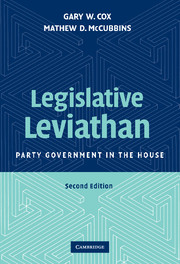Book contents
- Frontmatter
- Contents
- List of Figures
- List of Tables
- Acknowledgments
- Legislative Leviathan
- Introduction
- PART ONE THE AUTONOMY AND DISTINCTIVENESS OF COMMITTEES
- PART TWO A THEORY OF ORGANIZATION
- PART THREE PARTIES AS FLOOR-VOTING COALITIONS
- PART FOUR PARTIES AS PROCEDURAL COALITIONS
- PART FIVE PARTIES AS PROCEDURAL COALITIONS
- Conclusion
- Appendix 1 Uncompensated Seniority Violations, Eightieth through Hundredth Congresses
- Appendix 2 A Model of the Speaker's Scheduling Preferences
- Appendix 3 Unchallengeable and Challengeable Vetoes
- Appendix 4 The Scheduling Power
- Bibliography
- Author Index
- Subject Index
PART THREE - PARTIES AS FLOOR-VOTING COALITIONS
Published online by Cambridge University Press: 05 June 2012
- Frontmatter
- Contents
- List of Figures
- List of Tables
- Acknowledgments
- Legislative Leviathan
- Introduction
- PART ONE THE AUTONOMY AND DISTINCTIVENESS OF COMMITTEES
- PART TWO A THEORY OF ORGANIZATION
- PART THREE PARTIES AS FLOOR-VOTING COALITIONS
- PART FOUR PARTIES AS PROCEDURAL COALITIONS
- PART FIVE PARTIES AS PROCEDURAL COALITIONS
- Conclusion
- Appendix 1 Uncompensated Seniority Violations, Eightieth through Hundredth Congresses
- Appendix 2 A Model of the Speaker's Scheduling Preferences
- Appendix 3 Unchallengeable and Challengeable Vetoes
- Appendix 4 The Scheduling Power
- Bibliography
- Author Index
- Subject Index
Summary
In the previous part, we focused on the leadership of parties as the key to understanding their collective action. This suggests that investigations of parties as floor-voting coalitions ought to be conducted in terms of loyalty to party leaders and not, as has usually been done in the previous literature, in terms of general party cohesion. In other words, voting together (or failing to so vote) when the leadership is inactive or divided is one thing, and voting together (or not) when the leadership is active and united is quite another. Chapter 6 uses this basic point to reinvestigate and reinterpret the data on party voting in the House since the New Deal era.
Our reinterpretation relates to the notion of “conditional party government” (Rohde 1991). Conditional party government refers to a system in which the majority party leadership is active on an issue only when the party rank and file is substantially in agreement on what should be done. In such a system, decreases in party homogeneity will lead not to decreases in the support that leaders receive when they take a clear stand but rather to leaders taking fewer stands. This suggests a different view of how to measure the weakness (or strength) of parties as floor coalitions. In pursuing this view, we find little indication of a secular trend in the strength of the majority party on the floor of the House in the postwar era.
- Type
- Chapter
- Information
- Legislative LeviathanParty Government in the House, pp. 127 - 128Publisher: Cambridge University PressPrint publication year: 2007



